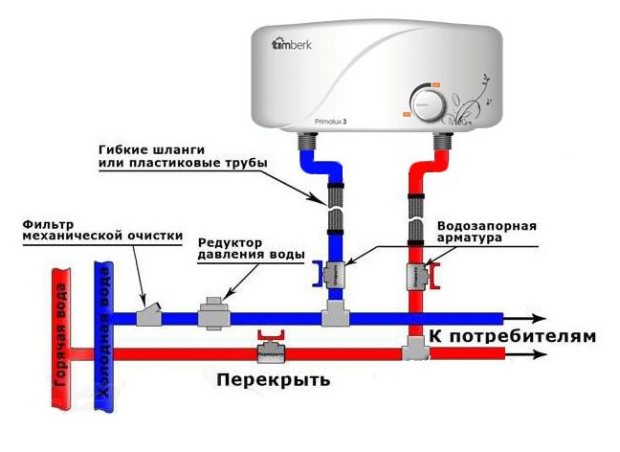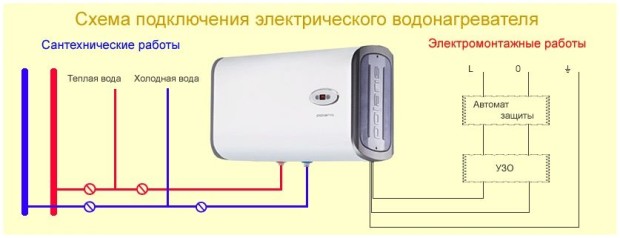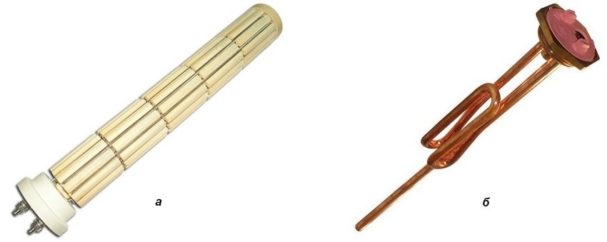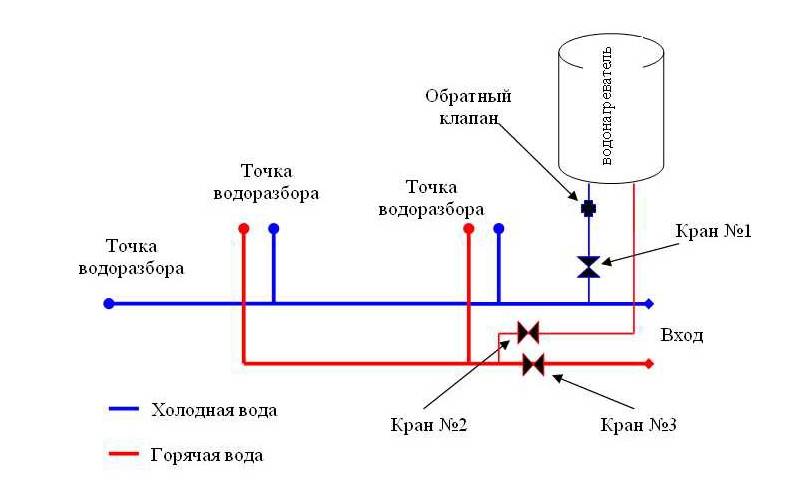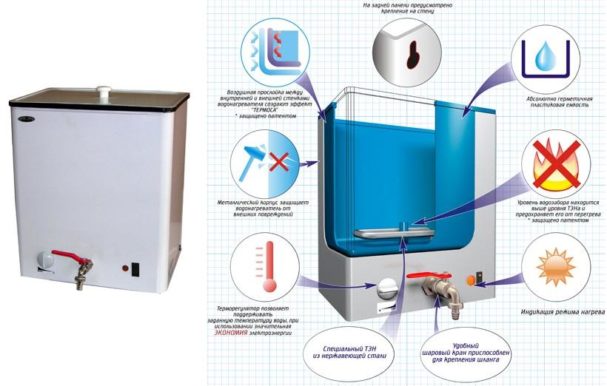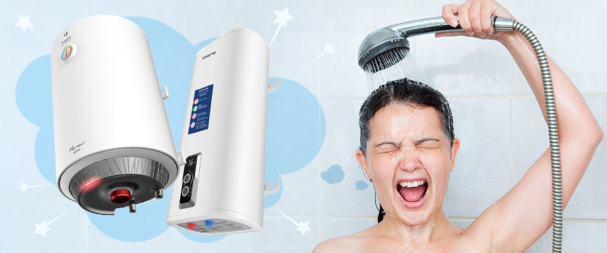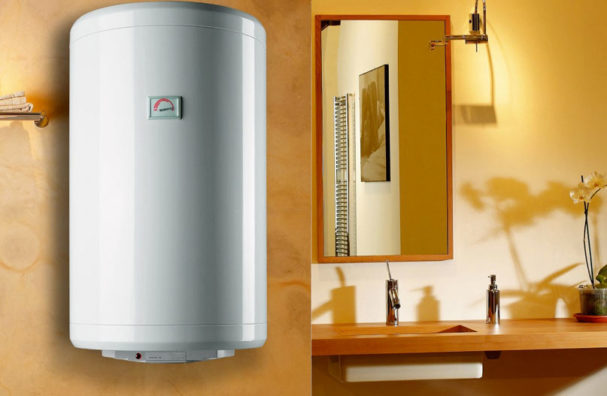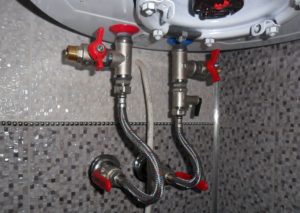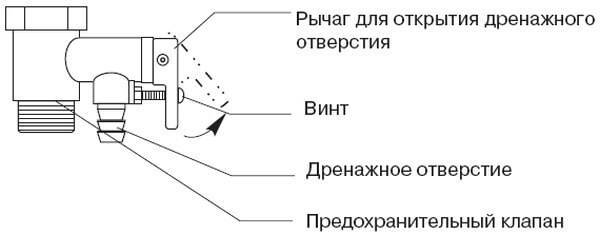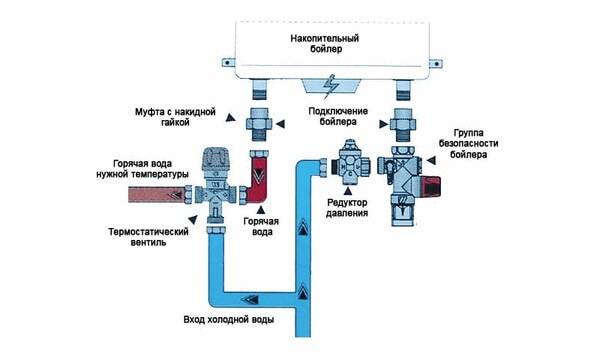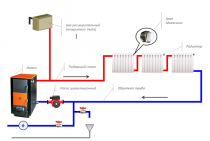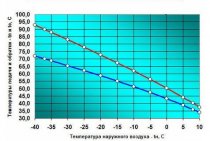Features of installing a water heater in the country
Installation location
Unlike an apartment and a private house, there are practically no restrictions on this. This is in residential buildings, it is necessary to take into account the location of plumbing, household appliances and a number of other factors. At the cottage, everything seems to be simple. But this is at first glance.
Basically, all the houses are light, frame. If made of brick, then a maximum of "1½". We need to see if the wall will hold up. On the one hand, such devices are not particularly heavy - within 3 - 5 kg. But do not forget about suitable pipes (inlet/outlet), which will be filled with water during operation.
If it is clear that the wall cannot withstand such a total load, you can either weld a frame for the heater from the corners, or additionally attach each pipe to the wall with brackets so that part of the load is removed from the water heater.
Connection
It is not worth considering the method of connecting pipes - the places of their joining are indicated on the device case by color. Cold water - blue, DHW - red. But email / connections - a separate topic for conversation.
Firstly, for all electrical household appliances characterized by high power, a separate line stretches, into which “their” RCDs and a circuit breaker are necessarily placed.
Secondly, the cross section of the conductor. It is calculated based on the power of the model. For summer cottages, as a rule, a simple heater is enough. But you should also take into account the margin of safety. If the model passport indicates power up to 8 kW (and these are mainly bought for summer cottages), then 4 “squares” are enough. But this is true for copper conductors.
Thirdly, you need to make sure that the input cable can withstand this additional load. In addition, one cannot discount its wear and tear (according to statistics, one of the main causes of all fires). You may need to change the wiring.
And all the other nuances are described in detail in the instructions for the model, and it makes no sense to duplicate its provisions.
Recommendation
The author does not advise taking a water heater to the dacha, which was previously used in the house, and then was taken out to the garage or barn as unnecessary (it's a pity to throw it away). There will be many problems with installation and fastening.
Even if this is a Chinese model, then you should not neglect it. After all, its operation on the site is only from time to time, and not as intense as in a home, so it makes sense to buy. Prices are quite reasonable - from 2,900 rubles. Even if it breaks relatively quickly - "the loss is not critical."
Water connection
Today, four main schemes for such a connection are used:
- For wall-mounted units, a three-way connection is used. Under certain and predetermined conditions, the thermostat built into the heater switches the valve, which allows the hot liquid to circulate through the heater coil located in the accumulator. As soon as the desired temperature is reached, a signal is sent to the system that stops circulation. Such a scheme for connecting the boiler to the boiler requires a special expansion tank and a circulation pump.
- The system of two pumps, in which the operation of the heating device is carried out only in one direction. When it is necessary to heat the water in the storage tank, the heating circuit circulation system is turned off and it becomes possible for the liquid to move into the storage tank. After heating to the desired temperature, the coolant begins to circulate in the heating system again, but the water heating stops. Such a connection of the boiler to the boiler has one significant drawback: from time to time it is necessary to interrupt the process of heating the home.
- Connecting the boiler to a multi-circuit system.This option is used when several heaters are used simultaneously to heat the building. For the normal functioning of such a system, scrupulous regulation by means of valves is necessary.
- Connection through the "arrow" - hydraulic manifold. A similar scheme is used when both the "warm floor" and the main heating work from one heater. A boiler that heats water from a gas boiler is also connected to such a hydraulic arrow.
 To connect pipes, it is best to use ball valves. In this case, the equipment has 2 connectors:
To connect pipes, it is best to use ball valves. In this case, the equipment has 2 connectors:
- blue - for cold water;
- red - for hot water.
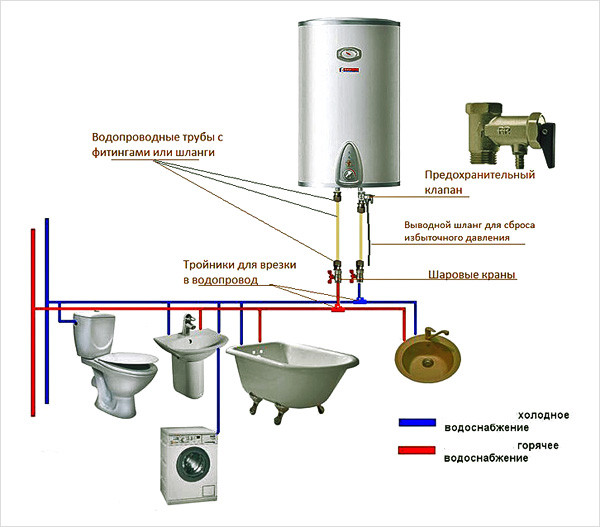
https://youtube.com/watch?v=M2_WSzsUzxE%3F
Choosing a heater dry versus wet
The "heart" of any electric boiler is a heating element (tubular electric heater). Unfortunately, in most cases, the failure of this home appliance is associated precisely with the failure of the heating element. In modern storage boilers, two modifications of electric heaters are used:
- "Dry" - are in a protective flask or capsule made of stainless steel, enameled steel (a).
- "Wet" - in direct contact with water in the tank (b).
Consider the differences between these designs, their advantages and disadvantages.
"Wet" heating element works like a boiler. Boilers with such a heater are an order of magnitude cheaper than those equipped with “dry” ones. There is an obvious disadvantage of such a design - intensive scale formation. It leads to overheating of the heating element, provokes an increase in electricity consumption. If you do not clean such a heating element from scale, then sooner or later it will simply cease to perform its functions. Another disadvantage is the formation of electrochemical corrosion, which also reduces the life of the boiler.
A boiler with a “wet” heating element can be chosen for an apartment if you have high-quality, soft water, or you have installed effective filters at the inlet of the cold water pipeline (reverse osmosis is optimal). In this case, a water heater with a "wet" heating element will serve you faithfully.
"Dry" heating elements are more reliable and durable. If you live in a region that does not boast excellent water quality, we would recommend giving preference to this type of design. Although boilers with protected heating elements are more expensive, they are not subject to the formation of scale and corrosion with such intensity as devices equipped with “wet” heating elements.
When choosing a boiler for an apartment, please note that “dry” heating elements with ceramic coating create less noise and keep heat longer. Such a boiler can be serviced without draining the water
Modern manufacturers equip some models with two "dry" heating elements. This option allows you to independently adjust the power of the device. Moreover, if suddenly one of the heating elements is out of order, you can use the second one until the master fixes the breakdown.
Despite the high cost, usually, buyers prefer to order boilers with a protected heating element, as they are more durable and do not create problems during operation.
The principle of taking water from the tank
There is one correct scheme for connecting a storage water heater, taking into account the features of its design and allowing you to quickly empty the tank if necessary. This need arises for the following reasons:
- scheduled cleaning of the tank and heating element from scale;
- the occurrence of a malfunction;
- moving or replacing the device with a new one;
- emptying the water heater in the country or in the house with periodic heating in the winter.
The connection of the water heater to the water supply, the scheme of its installation and placement must take into account that the water is taken from the upper zone of the tank. This is explained by the fact that at the top the water is the hottest, and in the lower zone there is a replenishment with a cold stream in the presence of water intake in the DHW system. The selection takes place through a vertical tube, the cut of which is located precisely in the upper zone.
The water from the tank must not be allowed to return to the cold water supply system, so the boiler is connected to the water supply through a check valve. At pressure drop in network as a result of turning off the water, the valve will not allow the contents of the tank to flow back into the pipe.
As a result of the standard connection of the boiler to the water supply, it cannot be quickly emptied by opening a hot water tap. Even unscrewing the DHW pipe from the fitting will not have an effect, since the water intake is too high, and there is a check valve on the cold one. The problem of draining is solved by a simple scheme for connecting the water heater to the water supply, assembled at the installation stage of the device.
Warranty support for the boiler what to look for
In our review, we left the question of the guarantee for the boiler in the end.
However, this does not mean that the warranty of such an expensive product is in last place in importance, quite the contrary! Remember that a manufacturer or retailer warranty will save you a lot of potential problems.
Agree that installing a boiler in an apartment is far from an ordinary phenomenon. To qualitatively build a water tank into your water supply system, you need to contact the experts, stretch the wiring, ground it. All this requires resources - time and money. Of course, any, even the most high-quality and expensive boiler, can go out of service. It will be very unpleasant if you have to fix the breakdown on your own, namely, the buyer of the device without a warranty card gets into such a situation. In this case, you will have to carry out diagnostics, repair and dismantling (if necessary) at your own expense.
Remember that a manufacturer's or retailer's warranty will save you a lot of potential problems. Agree that installing a boiler in an apartment is far from an ordinary phenomenon. To qualitatively build a water tank into your water supply system, you need to contact the experts, stretch the wiring, ground it. All this requires resources - time and money. Of course, any, even the most high-quality and expensive boiler, can go out of service. It will be very unpleasant if you have to fix the breakdown on your own, namely, the buyer of the device without a warranty card gets into such a situation. In this case, you will have to carry out diagnostics, repair and dismantling (if necessary) at your own expense.
A boiler that is not under warranty is most likely defective. Such a product can cause a lot of problems. Leakage or blockage of the safety valve is not so bad. We don’t want to scare you, but low-quality water heaters can explode, causing household injuries, flooding of neighbors, and many other troubles.
Here is another very important checklist that will allow you to analyze the quality of the boiler and avoid serious problems after its purchase:
- Manufacturer's official warranty.
- The qualifications of the specialists who install the device must be confirmed by the appropriate license.
- The operating water pressure must be within normal limits.
- The possibility of carrying out regular preventive maintenance of the product is subject to warranty service.
As you can see, a boiler without a guarantee is a time bomb. Tempted by the “democratic” price of the product, you can subsequently spend a lot on repairs and even the purchase of a new boiler.
Summing up, I would like to list the main advantages of a storage water heater
If you have not yet decided to purchase this household appliance, then pay attention to the following points:
- A boiler is a convenient accumulator of water. If you are alerted about upcoming maintenance of the water supply system and shutdown of water, you can make sure that this problem does not affect you.
- The boiler can supply pre-heated water, even during power outages.
- If you use a two-phase electricity meter, according to which the fee for "light" is lower at night, then the boiler can be used at that time of the day. This will save you a lot. You just turn on the boiler at night, and in the morning take a hot shower and wash the dishes, as usual.
When deciding to buy a boiler for a summer house or apartment, analyze the needs of your family. This will allow you to purchase a functional device that will serve you for a long time, creating comfort and coziness at home, regardless of interruptions in the supply of hot water.
Connecting the water heater to the mains
Since the operation of the water heater requires a connection to a 220V network and mandatory grounding, the best option would be to connect to an existing outlet for a washing machine - through a plug (of course, provided that this outlet is wired in a separate line in compliance with the rules).
If the apartment does not have such an outlet, then it would be best to turn to electricians for qualified help in laying electrical wiring. There are several reasons for this.
Perhaps this will prompt you to conduct an audit of the electrical wiring throughout the apartment.
Well, in conclusion, I would like to wish you pleasant water procedures.
Tags: water heater
How to use the water heater taps to close and open
Cranes indicated in the diagram by numbers "1" and "2" will be needed to turn off the water when the electric heater is not in use. For example, if we needed to remove the last one.
Cranes indicated in the diagram by numbers "3" and "4" available in any apartment connected to the central water supply, located after the risers, because we sometimes have to turn off the water for various reasons.
Let's pay attention to the tap "4" - it blocks the circulation of hot water between the apartment and the riser during the operation of the device. If the tap is not closed, then all residents of the entrance can use hot water from our water heater - the water will go to the riser
Main rule of use - if hot water is supplied by the city boiler house, the water heater is in the off mode - "1" and "2" taps are closed, and "3" and "4" are respectively open. If the boiler room “gets up” for prevention and the hot water is turned off, we connect our device to the 220V network, open the taps “1” and “2”, and close the tap “4”.
Self-assembly of the system
The procedure begins with the wall mounting of the device, and after that the question of how to connect the storage water heater is decided. Since the boiler has a significant weight, it is better to mount it with an assistant.During installation, regular fasteners and anchor bolts or other devices are usually used if the wall is wooden or is a frame sheathed with drywall.
To connect the water heater with your own hands to the water supply network, turn off the water supply in the house and follow the instructions:
- Screw a tee to the cold water supply fitting (it is painted blue), and a regular check valve (it is also a safety valve) to it.
- Connect a ball valve without an American to the tee. For ease of emptying, a 90° elbow with a hose fitting can be screwed onto it.
- Below the check valve, put a ball valve with an American. Install the same one on the hot water supply branch (marked in red on the water heater).
- Connect the installed fittings to the cold and hot water supply system.
In the absence of a sewer system, the tube is lowered into a transparent plastic bottle or canister. During the operation of the unit, the heated water expands, and its excess slowly exits through the spout of the safety valve.
Thanks to the assembled connection scheme, the boiler is easily emptied through a tee with a valve. Before draining, the cold water cut-off valve is closed, and the hot one is opened. You also need to open hot water at the nearest mixer, a maximum of 2 liters will flow out from there. Then the tap on the tee opens, and from there a drain occurs, the place of water in the tank is occupied by air entering through the mixer. Filling the container is easier: you need to open a cold shut-off valve and wait until water runs out of the previously opened mixer. But first, do not forget to close the valve on the tee.
Do-it-yourself storage water heater installation
Before proceeding with the installation, it is recommended to determine the bearing capacity of the wall where the heating device will be installed. Will it hold up? Still, the weight will be rather big. If there is doubt about the strength of the wall, then you can build a supporting stand or some additional brackets for the device.
Since there will be no immediate need to regulate the temperature, we do not consider the distance from the point of use in our case - we install the boiler where it is convenient for us.
Otherwise, everything is the same as in the case of проточным водонагреватеR»РµРј: we drill holes, drive in dowels and fix the water heater.
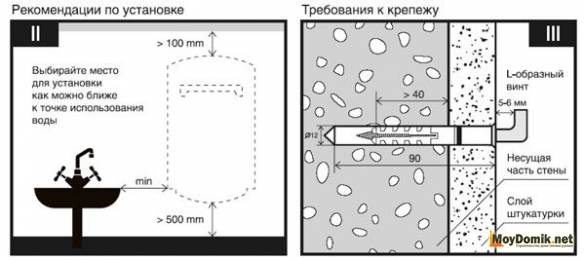
Boiler shape what to look for
It was not without reason that we began our review of a water heater for an apartment with this parameter. The fact is that its cost seriously depends on the shape of the boiler. Usually, round-shaped boilers are an order of magnitude cheaper than flat counterparts, since they take up more space.
If you have enough free space in your kitchen, then you can safely purchase a round model. Its average diameter is 500 mm
Suppose that there is not much space in the bathroom or in the kitchen - then you can pay attention to the Slim miniature round boiler, its diameter is not more than 385 mm. Of course, such a model will cost a little more, since you always have to pay extra for ergonomics.
But in the Slim electric heater, water reaches the desired temperature faster. What is the water consumption of such a model - you ask? Typically, such boilers are installed in an apartment where 1-2 people live. For a family of 3 or more people, a more efficient device is needed.
Let's talk about flat (rectangular) boilers. They cost more and are valued for their ergonomics, however, these are not all of their advantages. Inside the flat case, two water tanks can “hide” at once. Suppose you use a small amount of water every day, then only one tank works.But as soon as the need for hot water increases, for example, after the guests leave, when you need to wash a mountain of dirty dishes, you can start the second tank.
Volume matters
Before deciding to buy one, it is important to determine how much water you plan to use daily. In stores you can find water heaters of completely different capacities from miniature 10-liter to giant 300-liter boilers.
What kind of boiler to choose so as not to overpay for electricity and at the same time not experience a shortage of hot water? For one person, a boiler of 30-40 liters is enough, which will be properly installed in the bathroom.
Do you have a large family, do you plan to operate the water heater for dishwashing, cooking and hygiene needs? Then the minimum volume of the boiler that suits you is 100 liters. If you live in a private house, you can purchase a tank for 200-300 liters, but such a device will require a separate room and outdoor installation.
Depending on your needs and the location where you plan to install a water heater, its volumes can be as follows:
10-15 liters for the kitchen, since a 30-liter simply does not fit in the limited space under the sink, and hanging the tank in a conspicuous place is not always a good idea.
15–20 liters is the optimal boiler for a washbasin in a bathroom.
Do you want to take a bath? Then you will need more serious equipment - a 100-liter tank. If there is no space in the bathroom, then you can buy a more compact device with 80 liters.
If you have a shower cabin installed in your bathroom, then a boiler with a volume of 50–75 liters will be quite enough.
A large family with small children needs more water
Here you should pay attention to models from 120 to 150 liters.
When deciding on the choice of the volume of the boiler, pay attention to how much space this household appliance will take up. Having decided on the volume of the tank, it will be easier for you to calculate its cost.
How to connect a boiler in the country with your own hands
How to connect a boiler in the country with your own hands is an ambiguous question, country wiring, as a rule, does not involve significant loads. As can be seen from the article “choosing a water heater” Here, the advantage is with a storage water heater, because he is less greedy.
General tips for installing a water heater with your own hands
in addition to choosing the type and model of the device for heating water, before proceeding, it is necessary to determine the following important points:
- Throughout the entire period of operation, access to the device must be free.
- The wall on which the heater is supposed to be hung must have a double margin of safety, that is, when installing a boiler of 150 liters, it must withstand a load of 300 kg.
- If the wiring in the apartment has not changed for a long time, then invite a specialist to determine its condition and cross section, and also whether it can withstand the load from the device you have chosen. After the examination, you will know for sure whether you need to change the wiring or not.
If you purchased a boiler with a power of up to 3 kW, there should be no difficulties with connecting to the electrical network.
Electrical connection
It is enough just to follow the rules for connecting the water heater to the mains and there will always be hot water in the house:
- The location of the outlet in such a place that accidental splashes of water do not get there.
- Connect the boiler only when installing grounding. To do this, you need a three-pole socket and a three-wire wire.
- It is desirable to bring all electrical wire connections outside the bathroom.
- To connect the boiler to the mains, use an individual socket.
Work procedure:
- Make a measurement of the distance from the outlet to the boiler.
- Disassemble the boiler plug into parts.
- Remove the insulation from the cable. Strip the veins with side cutters.
- Solder the wires to the pins of the plug.
Combine the red wire with the phase, yellow-green or black - ground, and blue - zero.
- Remove the cover from the boiler and open the contacts.
- Strip the wires at the other end of the cable. Connect to the boiler contacts and replace the cover.
There is another option for connecting the boiler, this is connecting directly to the electrical panel:
- Lay the cable from the boiler to the shield.
- Install an automatic machine next to the boiler and run the cable through it.
- Remove 10 cm of insulation, expose the phase from the machine and connect to the upper terminal on the machine. Connect the phase from the boiler to the bottom terminal.
- Clean the ends of the cable from insulation, release the cores.
- Unscrew the cover, connect the cable cores to the boiler terminal.
- Turn off the power and connect the cable to the electrical panel.
Water connection
Today, four main schemes for such a connection are used:
- For wall-mounted units, a three-way connection is used. Under certain and predetermined conditions, the thermostat built into the heater switches the valve, which allows the hot liquid to circulate through the heater coil located in the accumulator. As soon as the desired temperature is reached, a signal is sent to the system that stops circulation. Such a scheme for connecting the boiler to the boiler requires a special expansion tank and a circulation pump.
- The system of two pumps, in which the operation of the heating device is carried out only in one direction. When it is necessary to heat the water in the storage tank, the heating circuit circulation system is turned off and it becomes possible for the liquid to move into the storage tank. After heating to the desired temperature, the coolant begins to circulate in the heating system again, but the water heating stops. Such a connection of the boiler to the boiler has one significant drawback: from time to time it is necessary to interrupt the process of heating the home.
- Connecting the boiler to a multi-circuit system. This option is used when several heaters are used simultaneously to heat the building. For the normal functioning of such a system, scrupulous regulation by means of valves is necessary.
- Connection through the "arrow" - hydraulic manifold. A similar scheme is used when both the "warm floor" and the main heating work from one heater. A boiler that heats water from a gas boiler is also connected to such a hydraulic arrow.
Connecting the storage water heater to the water supply scheme
Installing a storage water heater requires a more thorough approach. In addition, it allows you to use hot water from the appliance throughout the apartment.
Scheme of the device storage water heater
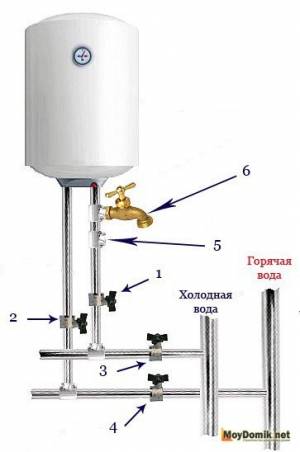
Notation "hot water" and "cold water" - these are "risers" - two pipes that pass through all the apartments of the entrance and supply them with water (cold and hot).
1-2 - water taps. They block or open the circulation of water to the tank and back from the water heater. When the device is working, the taps are opened, if not used, then, of course, they are closed.
3-4 - water taps introductory to the apartment. They are necessary to shut off the water supply to the apartment.
5 one of the important elements check valve. It is necessary to protect the heating element of the electric water heater from overheating (in the event of a shutdown of cold water, the water heater tank is not left without water and its heating elements will not burn out).
Any good storage water heater includes such a protective device. Be careful when checking the package!
6 - drain valve - a tap that is designed to empty the storage tank of the water heater.For obvious reasons, such a tap must be provided during the installation of the water heater: before dismantling (if necessary) the water heater, it will drain all the water from the tank. After all, depending on the capacity of the water heater, there can be 100-150 liters of water in the tank ....
Inlet and outlet units
How to connect the water heater to the water supply? To do this, auxiliary units are placed on one pipe entering the boiler and on the other pipe leaving it.
What is placed on the inlet pipe?
Cold water is supplied to the heating tank in the same way as to a bath or kitchen sink faucet. With the help of a tee, a separate branch of the water supply is created, coming from the consumer line. This is the inlet pipe to the tank, on which a check valve is installed to prevent the outflow of heated water into the cold line.
When connecting a water heater to the water supply system, taps are placed up to and behind the valve: the one that is higher (closer to the boiler) is drain, and the one below is shut-off. If it is necessary to remove the boiler, then the water supply is shut off with one tap, and it is drained from the tank through the other.
Valve features
Often a check valve is combined with a safety valve in one L-shaped body. It turns out one unit.
The safety valve bleeds water when the pressure in the tank is higher than the allowable one.
There are modifications with a lever (flag) with which you can open the water outlet from the boiler and release water from it. With this design of the valve, the drain cock will be superfluous.
A transparent polyvinyl chloride (PVC) hose is put on the fitting through which water will be drained and lowered into a suitable container or into a washbasin.
Scheme of the water heater check valve.
Heaters larger than 60 liters may be sold complete with stopcocks and valves. Therefore, it is better to buy spare parts after purchasing the boiler.
When mounting any valve, pay attention to the arrow shown on the body. It shows the direction of water movement
At the outlet of the boiler
How to connect the boiler to the water supply at the outlet of the tank? The beginning of the line of hot water consumers is the outlet pipe from the heating tank. On it, sometimes, a shut-off valve is placed. But it is not necessary to do so.
To drain the water when dismantling the boiler, only one of the stopcocks is enough: the one that is installed on the inlet pipe. The rest of the water will go away after opening the valves (hot line) of the faucets in the bathroom and in the kitchen. Scheme of connecting the water heater to the water supply.
